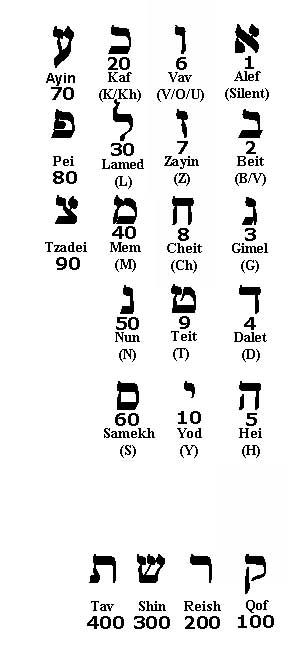Hebrew Numerology
Hebrew numerology is based on the fact that Hebrew numbers are traditionally written by using letters of the Hebrew alphabet.
Each Hebrew letter corresponds to a number, with no notation for zero. (Mystics like this fact, deriving much homiletic material from it, not least, that since there is a G-d, there is never nothing …)
Because of this, numbers can spell words, and words add up to numerical values.
Here's how Hebrew numerology works.
Hebrew Numbers
The first nine letters of the alphabet correspond to the Hebrew numbers 1-9. The next nine letters to the tens units (10-90), and the last 4 letters of the Hebrew alphabet to the first four hundreds (100-400).

Numbers over 10 are formed by combining letters, whose numerical equivalents are added together, rather than used symbolically. For example, the Roman numeral 11 is formed by combining 1 and 1 who together form a symbol for 11. In Hebrew, however, 11 is indicated by the combination of the letters א, whose value is 1, and י , whose value is 10. Together they add up to 11 – י"א . In this vein, 12 = י"ב = 13 , י"ג and so forth.
Two notable exceptions are the numbers 15 and 16, which instead of being formed by adding 10+5 and 10+6, are written as 9+6 and 9+7. This convention is because the 10+5 and 10+6 combination of Hebrew letters would result in spelling G-d's name, something Jews traditionally avoid. Thus, 15 = ט"ו and 16 = ט"ז
This system of adding numbers/letters to show a number larger than 10 requires 27 letters. The Hebrew alphabet has only 22. What do we do?
We
use the last letter of the alphabet – ת which stands for 400 – in
combination with the other letters whose values are in the 100s, to make
up the numbers from 500 to 900.

To show that the letter combinations are in fact used as numbers, you insert gershayim – similar to a quotation mark - before the last letter in the combination.
A single geresh is used after a single letter when it is being used as a number.
Thousands are often indicated by a single letter, followed by an apostrophe (a geresh). For example:
The Hebrew year 5773 (2012-2013 in the Gregorian calendar) is written like this: ה'תשע"ג
The 'ה with the geresh indicates 5000, followed by 400 (tav) + 300 (shin), then 70 (ayin) and 3 (gimmel). The 5000 is often dropped when writing the year, so you’ll usually see dates written simply as תשע"ג.
Modern Use of Hebrew Numerology
In Israel today, Hebrew numerology is used to write the Hebrew date, to cite to traditional sources like the Bible, and to number lists or outlines.
Because Hebrew numbers are formed with letters, you may hear Israelis using the sounds of the letters instead of the proper word for the number.
One example of this is the Jewish holiday of Lag BaOmer. Literally, the name of the holiday means the "33rd day of the Omer." Instead of using the words sheloshim ve shlishi (33rd), it has become the custom to use the word Lag, a vocalization of the letters lamed and gimmel which are used the write the number 33.
You'll also hear Israelis refer to days of the week by the letter of their number. While Monday is called yom sheni in Hebrew (literally “the second day”), Israelis will often call it yom bet since the letter bet stands for the number two.
The literal meaning of letter combinations used as numbers, or vice versa, the numerical value of the letters making up certain words forms the basis of the mystical discipline of Hebrew gematria.
Hebrew Numerology > Learn to Speak Hebrew page.
Hebrew Numerology > Jerusalem Home page
Don't Miss What's New in Jerusalem!
Stay up-to-date with all that's new in Jerusalem and on this site. Subscribe to the RSS feed at the top of the navigation bar over on the left and you won't miss a thing.
And sign up for our free monthly newsletter to stay abreast of what's
going on, as well as new discoveries, seasonal events, cool Jerusalem tours and
exciting activities.
Subscribe to Our Newsletter
